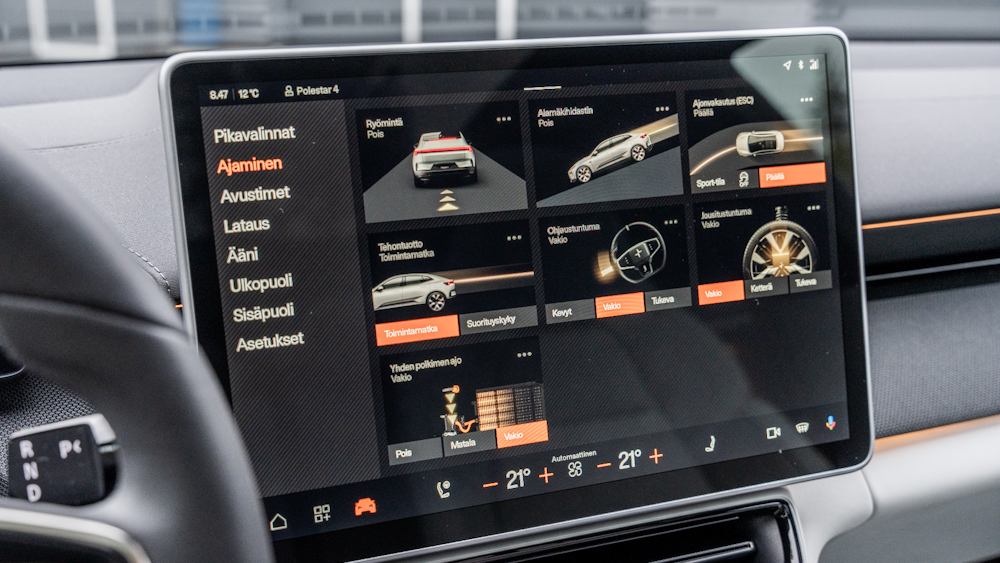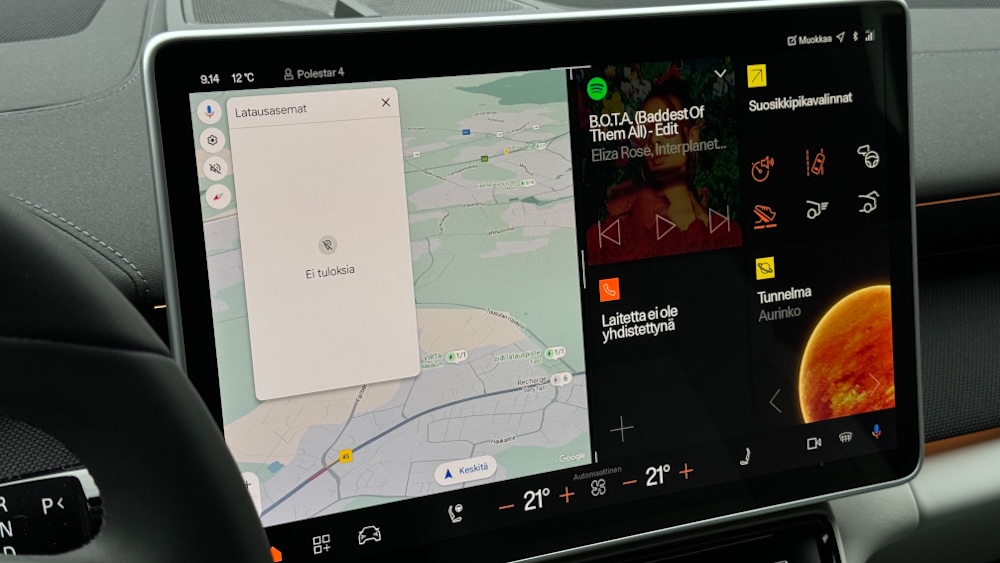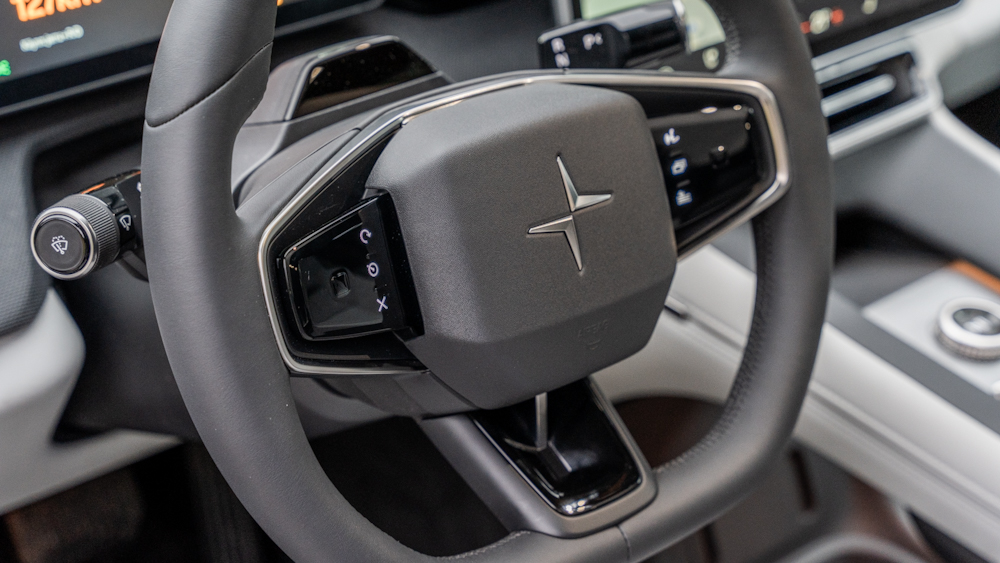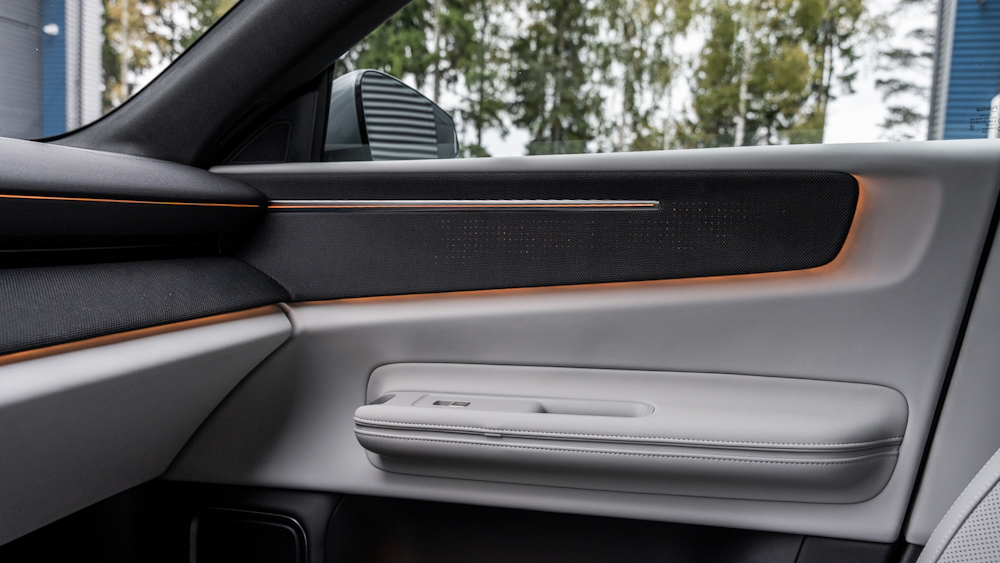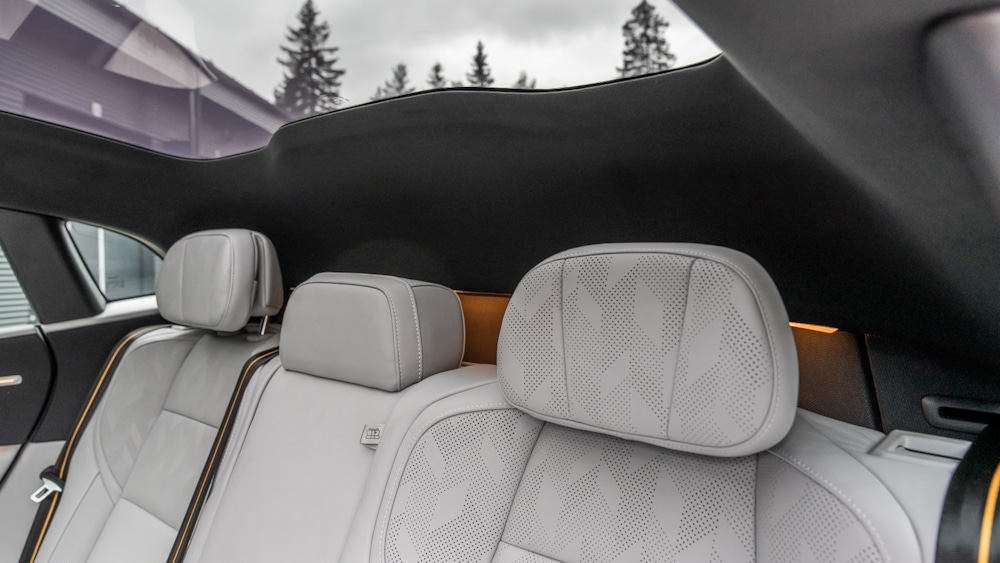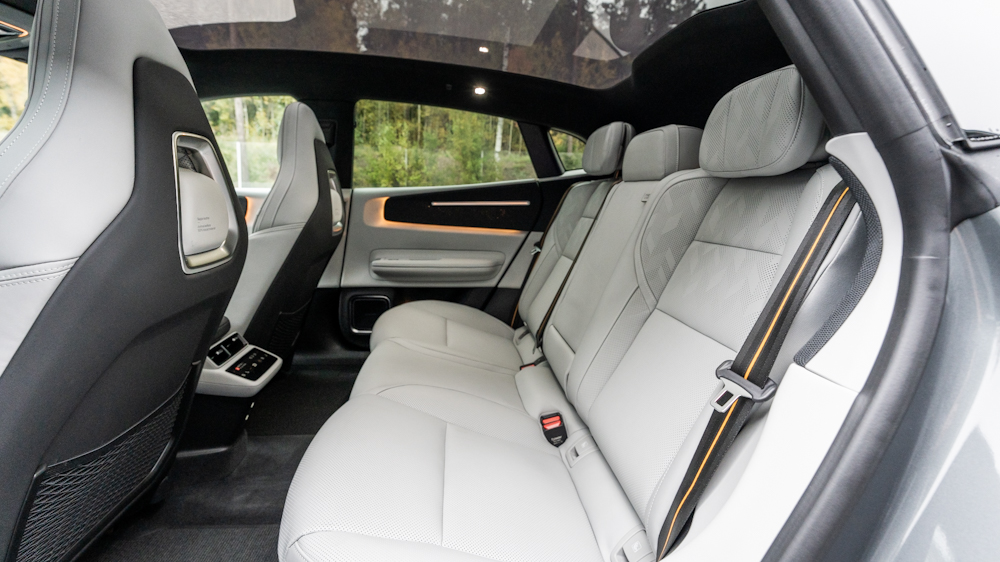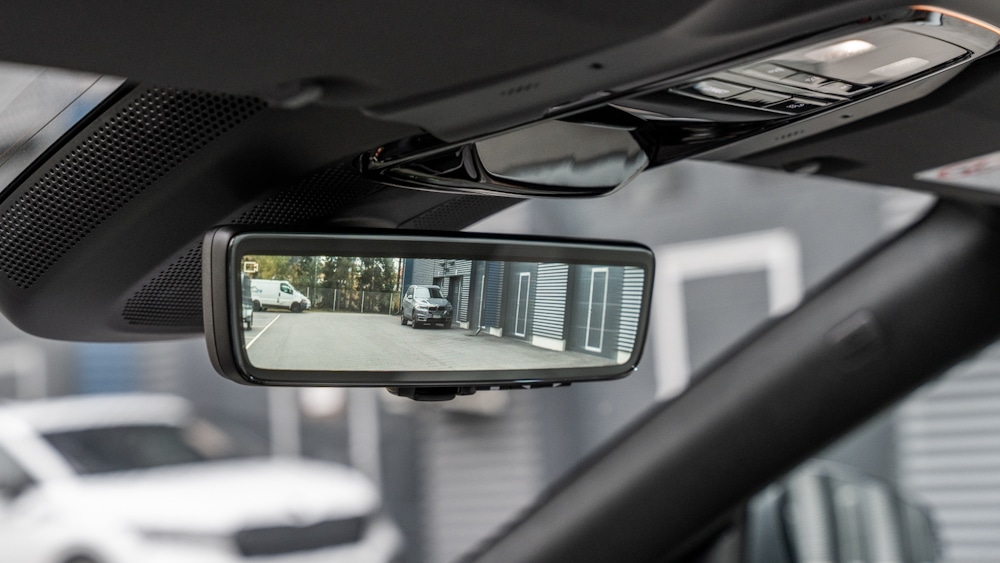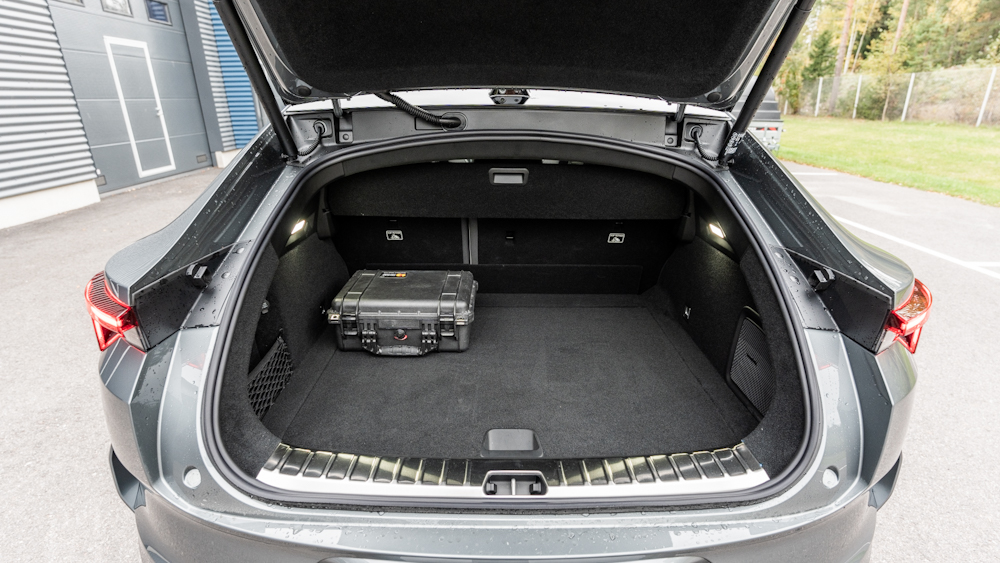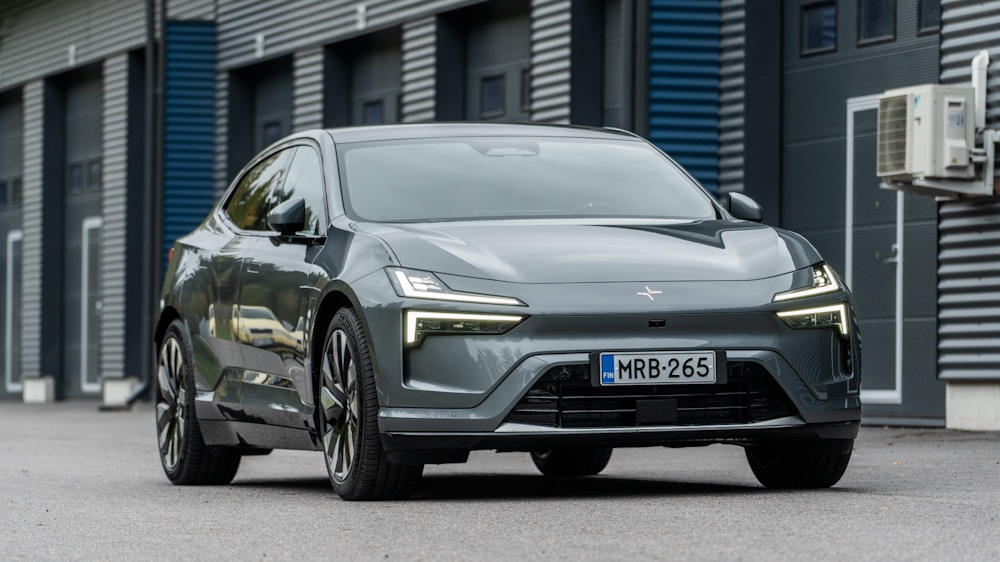Rectangularity and originality of design have been trademarks of the Polestar brand from the very beginning. Polestar 4 takes its design into a whole new century. The manufacturer calls it a cross between a high-performance SUV and an innovative coupé.
The Polestar 4 sits firmly on the road and the sporty styling doesn’t give the SUV feel the manufacturer first advertises.
Instead, at almost five metres tall, the Polestar 4 is a stunning coupé. The car is more than two metres wide, and the low, aggressive look of the front in particular is not overlooked.
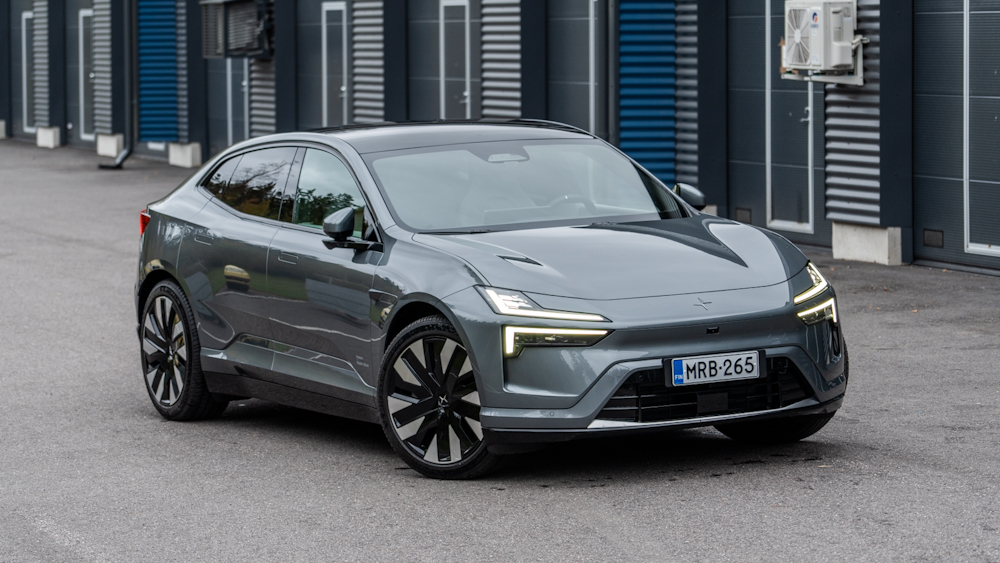
The roofline slopes gently towards the rear. However, the headroom for rear passengers has not been compromised. The rear of the car has been left high in comparison to the rest of the design, allowing not only headroom but also a generous boot of over 500 litres for its size, despite its coupé design.
The rear window has been completely omitted and the rear view mirror is formed by the camera.
Space and quality
In addition to the car’s width, the long wheelbase makes for a spacious interior. In terms of length, even a long-legged driver will not run out of space in the back.
The rear seats also offer excellent comfort. The absence of a rear window adds to the ambience and privacy for rear passengers, while the electric tilting of the seat backrest makes long journeys easier. Even if the comfort in the back is not quite up to the standard of a prestige car, Polestar pales in comparison with many competitors in the same category.
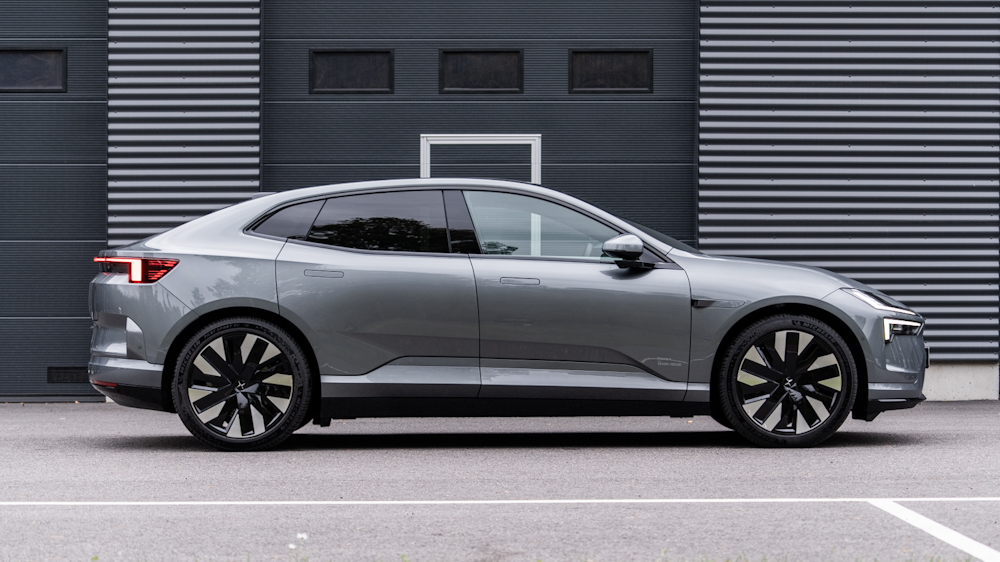
In addition to space and good visibility, the front passenger comfort is ensured by the excellent seats, which in the test car were upholstered in the valuable five thousand euro nappa leather upholstery from the options list.
In addition to the nappa leather, you get seat cooling, massage functions and speakers for the headrests in return for the high price.
The cabin has also been designed with usability in mind. There is plenty of storage space under the centre console and the ergonomics of the cabin are good.

The centre display is in a horizontal position, which is much better than the vertical display in terms of usability.
The horizontal display also allows for a better visual presentation of things, without having to take your eyes off the road as much.
The centre display’s ‘home page’ provides easy access to shortcuts to key driving-related controls and mood lighting. The regeneration level for single pedal driving is easily adjusted from the same menu. A Google map always fills at least half of the home page.
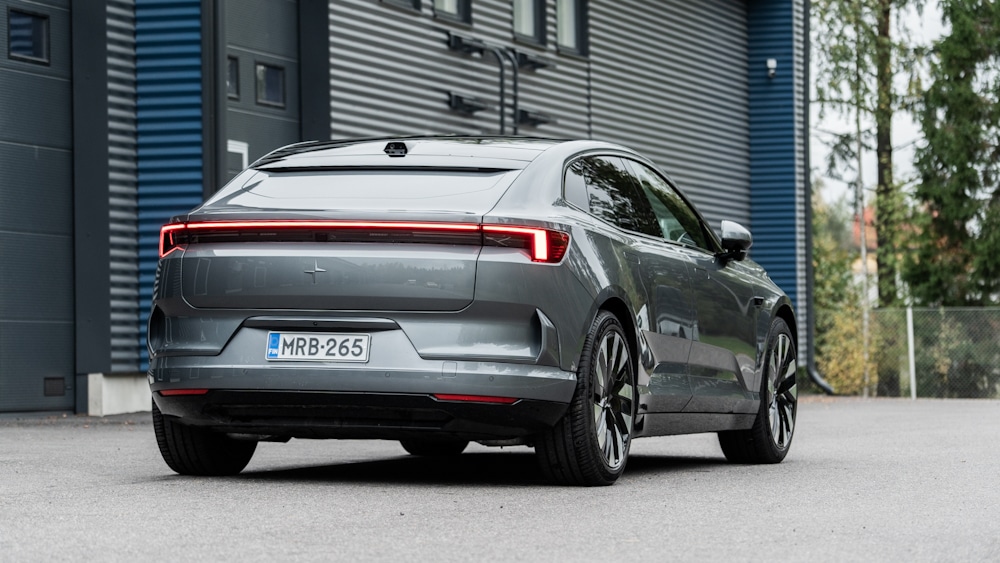
As usual, the visual appearance and usability of the centre screen is very clear. The text font is large and the main colours black, white and orange add a sporty feel. The menus are clear and there are no annoying delays in the screen’s response to touch.
The keyless car also deserves praise. During the week-long test drive, the keyless car performed flawlessly, with the door handles pushing out like a dream every time you arrive at the car. This was not the case with the Polestar 3, where the communication problems between the key and the car were unnecessary.
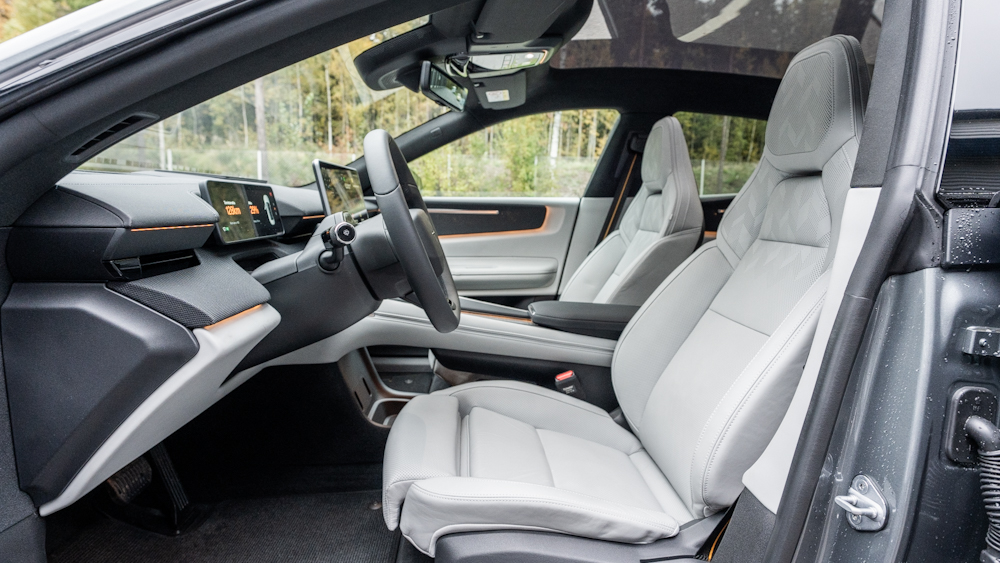
The quality and feel of the interior is high. The manufacturer’s development work can be seen and felt, and although the Polestar 2 and 4 are not comparable models in the same price range, the production has taken a visible leap forward in quality and design.
Excellent ride quality after a little tweaking
The Polestar 4 is already a car that’s worth trying out, especially on a more twisty road. On the road, there are no complaints, the interior noise is kept quite low on 21-inch summer tyres and the ride is effortlessly stable. However, it was only on the rougher bends that you really got an idea of the true nature of the ride.
After straying onto an unpaved country road for several tens of kilometres, the car’s driving dynamics were put to the test. The car absorbed the curls and bumps of the gravel road surprisingly well.
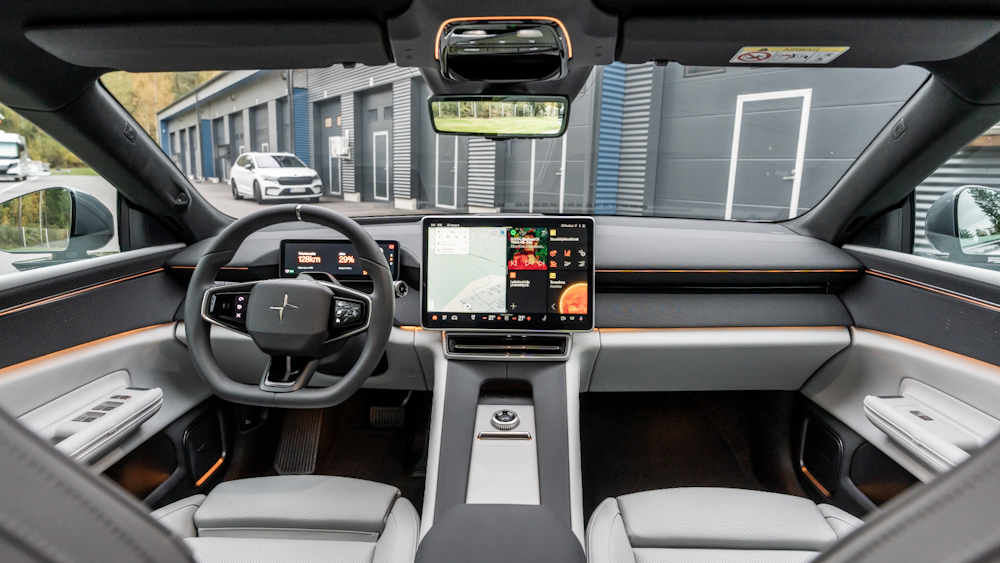
In the twin-engine Dual Motor model, the standard and actively adjustable shock absorbers did an excellent job. The chassis feel can be adjusted to three different levels, and with the ‘Firm’ setting, the shock absorbers provided a remarkably snappy response to road irregularities.
Like the chassis, the steering feel is precise and quite quick. “On the ‘Light’ setting, the steering is clearly too light if you want even the slightest bit of feel. Fortunately, the steering feel can be adjusted between three settings to make it more tactile and stiffer.
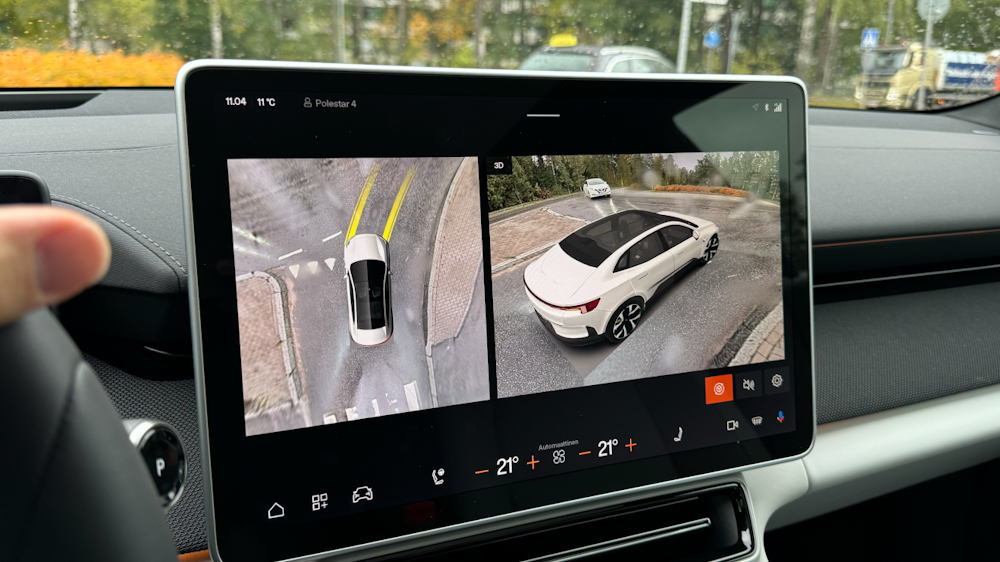
The throttle response, on the other hand, would require some software coding. With the tamer “Operating distance” setting, the throttle response shows an annoyingly small delay, probably for economic reasons. “On the ‘Performance’ setting, on the other hand, the car does not seem to lack go-ahead and the pedal response could even be calmed down a little.
However, the aforementioned steering and throttle response wrinkles are quite minor in the love that the Polestar 4 offers its driver in terms of drivability in different conditions.

The driving automation does its job with varying degrees of success. The cruise control engages with a slight delay after pressing the button and on three occasions the cruise control did not work at all.
The haptic buttons on the steering wheel took less than a week to get used to and the user experience is not very pleasant, especially as the functions work with varying degrees of success.
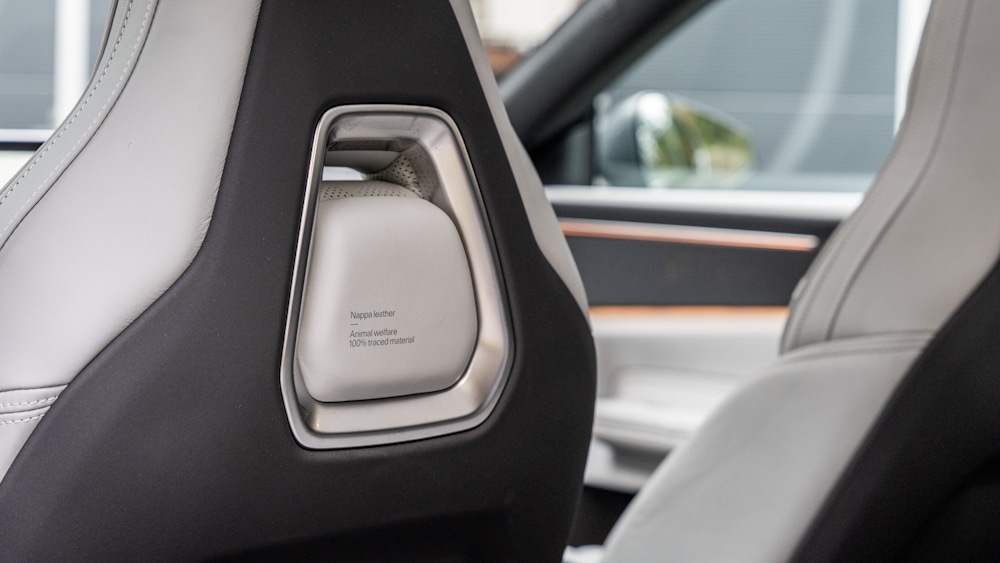
The automatic lane-changing function seemed to be easily interrupted if you put too much weight on the steering wheel with your hand. The Google-based car map worked well for the most part, but behind the charging stations shortcut, for example, the car could not list the nearest charging stations, even though the map clearly shows the different service providers and charging stations.
Pilot Assist keeps the car accurately centred on the lane lines with cruise control, as long as you remember to keep your hands on the steering wheel and gently follow the movement of the steering wheel.
Reasonable fuel consumption
During the test week, outside temperatures ranged between 4 and 13 degrees Celsius. The average consumption over the long run was 22.3 kWh/100 km, and on the motorway at 120 km/h the consumption rose moderately to only 24 kWh/100 km. At its lowest, consumption hovered around 20 kWh/100 km.
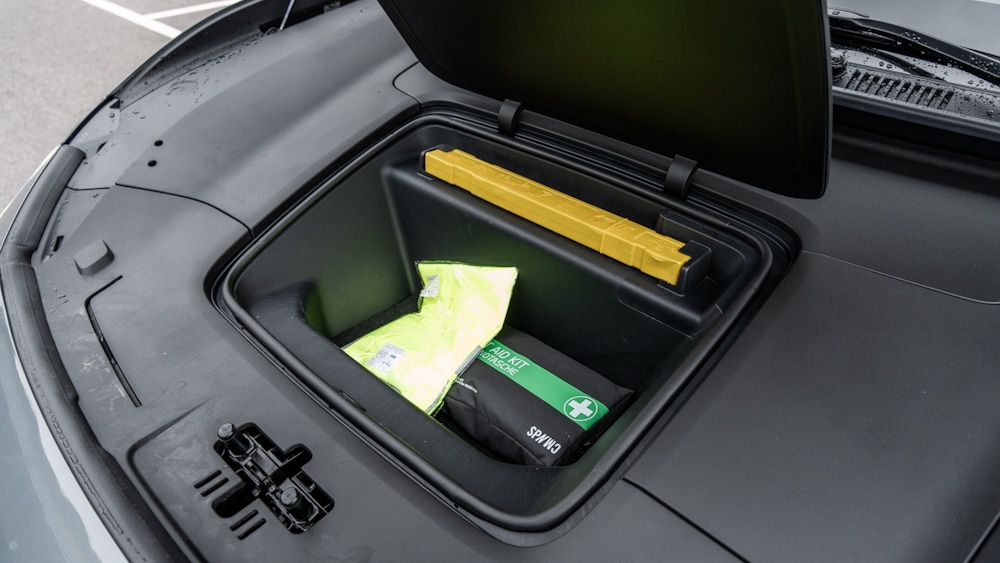
The sat nav gives an estimate of the battery charge level on arrival at the destination. These estimates were very accurate over several hundred kilometres, and were often pessimistic by as much as a few percent.
The Polestar 4, regardless of the power line, will always come with a 100 kilowatt-hour battery, which, with the test drive consumption tested, will enable it to cover a distance of more than 400 kilometres. The manufacturer claims that fast charging can be achieved within 30 minutes (10-80%), which has already become an industry standard.
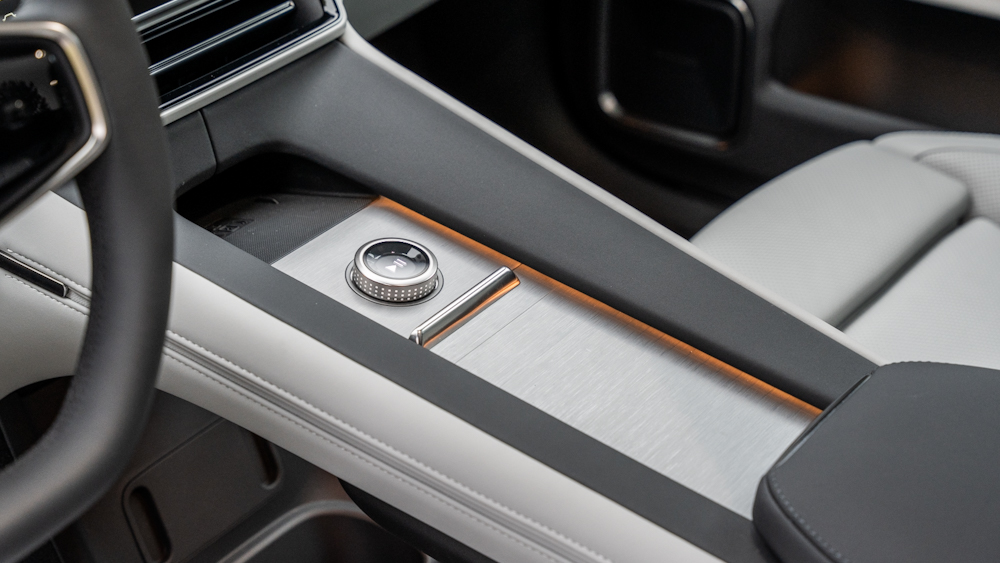
Unfortunately, the test car had problems with battery pre-heating, and the peak charging power was only measured at 125 kilowatts. The importer assured us that the preheating would be fixed in the near future with upcoming updates.
Overall, Polestar has done an excellent job with the Model 4. Not only does the car look sporty, it scores high marks for drivability. The original design and personal feel continues inside the car, where quality and space are enjoyed both in the front and the rear.
Future software updates will hopefully also bring the software up to the premium level that the rest of the car already represents in terms of iron. The Polestar 4 is not in everyone’s budget, but for once, it’s value for money.
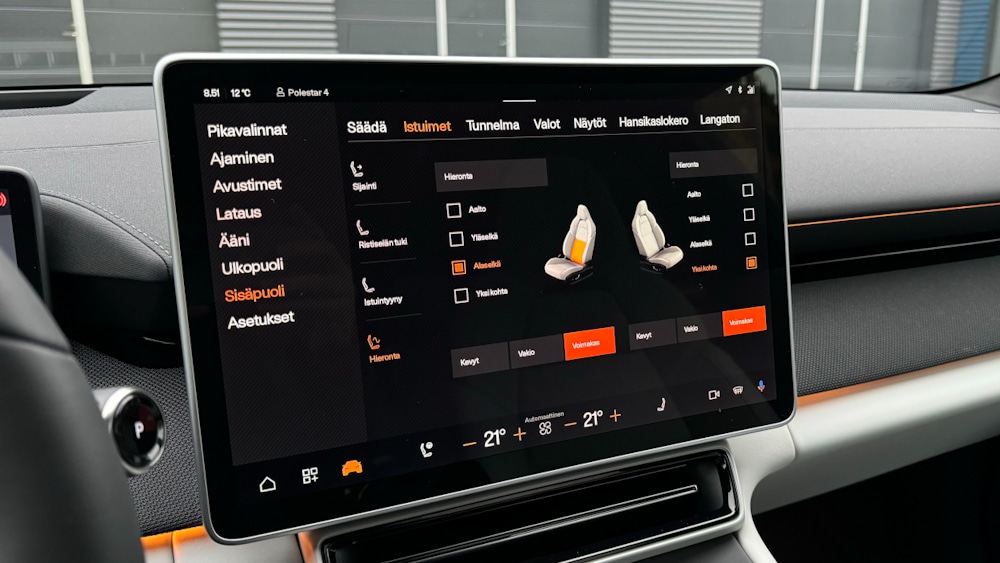
Polestar 4 Long range Dual motor
- Electric motor power: 2 x 200 kW. (total 400 kW. / 544 hp.)
- Total torque of the electric motors: 686 Nm.
- Acceleration: 3.8 sec. (0-100 km/h)
- Driving battery capacity: 100 kWh.
- Manufacturer’s declared combined fuel consumption: 18.7-21.7 kWh/100km.
- Manufacturer’s declared range (combined): 590 km (WLTP)
- Electricity consumption during test drive: 20-24.5 kWh/100km (4 – 13 ⁰C)
- Test-driven range on a single charge: approx. 400-500 km.
- Maximum charging power (DC): 200 kW.
- Maximum charging power (AC): 11 kW. (norm) / 22 kW. (Plus package)
- Cargo space: 526 – 1536 l.
- Drive mode: four-wheel drive
- Towing capacity (with brakes): 2000 kg.
- Starting price of the test drive model: 70 200 euro
- Price of the test car with options: €88 000 (13.10.2024)
- Starting price: €64 100 (Long range Single engine)
- Warranty: car 2 years (manufacturing defects) ; battery 8 years / 160 000 km.
- Country of manufacture: China
